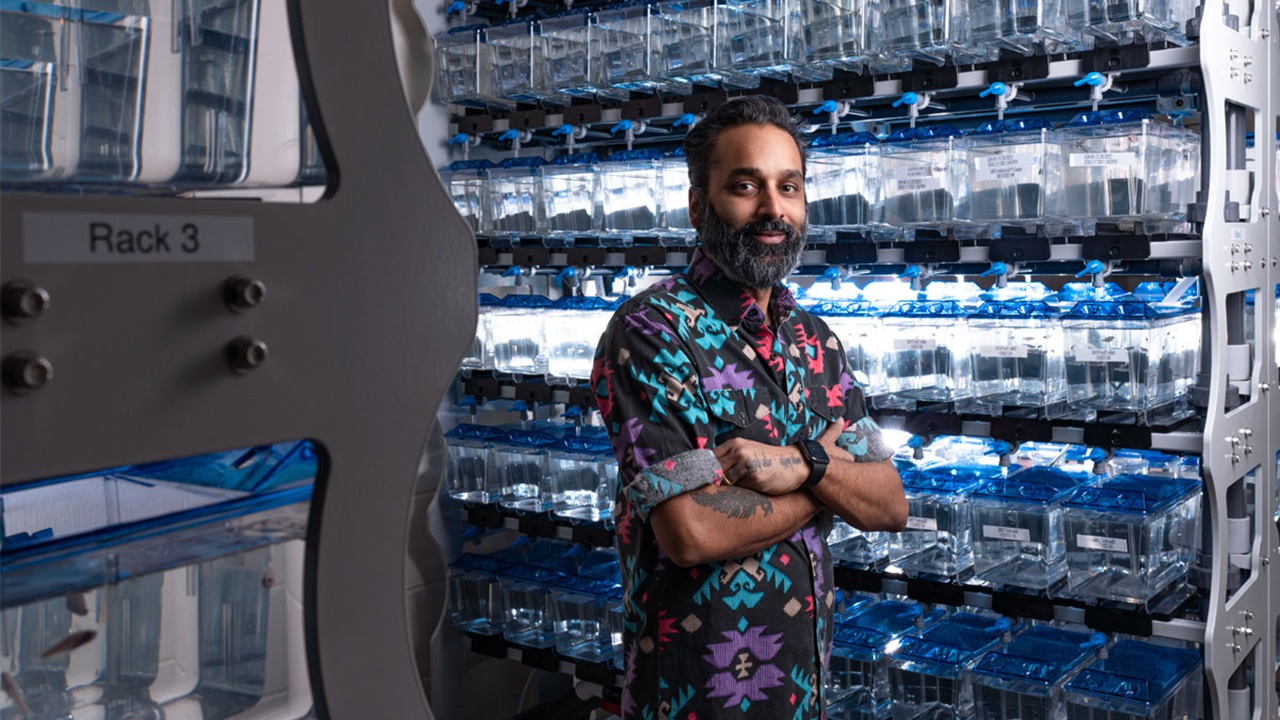USD Researcher Uses Fish to Study Fetal Alcohol Spectrum Disorders

Not only do zebrafish and humans share 80% of the genes that are linked to disease, but these fish are also social animals, said Yohaan Fernandes, Ph.D., assistant professor of biology at the University of South Dakota. These traits, among others, make them ideal for use in FASD research.
“For research purposes, we need something that strikes a balance between simple and complex enough to ask questions that are related to humans. Zebrafish strike that balance,” said Fernandes, who received a grant from the National Institutes of Health to study the interplay of genes and the environment on the social and cognitive deficits associated with FASD.
According to the Centers for Disease Control and Prevention, FASDs are a group of conditions that can occur in a person who was exposed to alcohol before birth. Estimated to impact approximately 5% of children born in the United States each year, individuals with FASD exhibit a wide range of structural and cognitive deficits.
In the form of ethanol, Fernandes examines how alcohol exposure can affect embryonic zebrafish at the molecular level. Zebrafish embryos are ideally suited for testing different levels of exposure to ethanol since they are externally fertilized. This allows researchers to place the embryos in an ethanol solution of different concentrations and for different lengths of time.
Additionally, the zebrafish’s natural tendency to form shoals – or a group of fish – can be leveraged to characterize the effect embryonic alcohol exposure has on the brain and social behavior.
“Zebrafish show an increase in dopamine levels when they are given social opportunities,” said Fernandes.
Fernandes uses transgenic zebrafish with green fluorescent protein tagged to dopamine neurons, zebrafish lines in which dopamine neurons are absent, advanced microscopy and behavioral analysis to characterize how embryonic alcohol exposure interacts with the dopaminergic pathway.
Additionally, Fernandes uses CRISPR gene editing techniques to determine whether particular genes protect or enhance the effect embryonic ethanol exposure has on brain and behavior.
The social nature of zebrafish also allows Fernandes to consider how environmental changes can help diminish the social deficits associated with FASD.
“We’re looking at the role environment plays,” he said. “If the fish who are exposed to alcohol as embryos are then put into a positive environment—either with fish that are unexposed or the right number of fish—can that mitigate their deficit?”
This research marries two of Fernandes’ interests that date back to his undergraduate studies. While working in the biology lab of a professor who studied alcohol’s effects on adult zebrafish, Fernandes was also pursuing a specialization in exceptionalism and learning. At the same time, his sister worked with individuals who had FASD and relayed her experiences to him.
“She told me a striking story about how this child knew that there was something slightly wrong, but didn't really understand why,” he said. “She would ask: ‘Why can’t I go to these parties? Why am I not invited?’ And this really struck a chord with me.”
Fernandes combined his interests and developed a zebrafish model of FASD social defects. He began this work as an undergraduate student and has continued building on it throughout his doctoral and postdoctoral work. Fernandes continues this research at USD.
His wife, Mindy Fernandes, has been working alongside him since graduate school. She now manages the lab at USD.
“We have worked side by side over 10 years -- she is my compass,” said Fernandes. “Mindy and I have published many papers together. She is great with students and has a keen eye for learning studies. I wouldn’t have it any other way.”
His research examines fundamental mechanisms to try to explain how alcohol exposure affects embryonic development and how developing interventions can help individuals with FASD lead more fulfilling lives.
“One avenue would be finding a treatment that is chemical,” Fernandes said. “The other avenue is finding a way to provide enrichment in the environment. If we can show strong proof that we can help people, that would be really exciting.”


